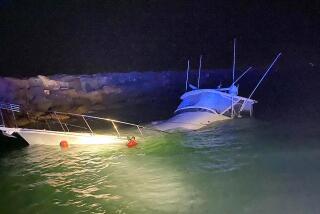Navy Target of Civil Trial : Bay Hazard Alleged in ’84 Speedboat Deaths
- Share via
Unsafe conditions in Anaheim Bay and not pilot Virl Earles were responsible for a 1984 speedboat crash that left five dead, according to testimony in federal court Wednesday.
Earles, who was convicted of manslaughter after the crash, four other survivors and relatives of the five dead began civil trial this week of their claim that Navy carelessness made Anaheim Bay unsafe for the pleasure boaters who used it jointly with military vessels.
Claims exceed $20 million in the trial before U.S. District Judge James Ideman.
Conviction Appealed
Earles, 32, of Westminster is also appealing his involuntary manslaughter convictions and three-year prison sentence in the deaths of five friends when the speedboat he drove plowed into an unlighted mooring buoy on Oct. 28, 1984.
Government lawyers have denied that the bay is or was unsafe and assert that Earles’ negligence in driving the boat was the cause of the crash.
A test done on a sample of Earles’ blood after the accident showed an alcohol content slightly above 0.10%, the minimum level in California at which an automobile driver is presumed to be under the influence of alcohol.
But that evidence was excluded at Earles’ criminal trial because it was illegally taken. In an extraordinary courtroom drama, jurors who convicted Earles urged that he not be sent to prison, with the foreman saying there was “no reason to make him endure any more.”
Ideman has yet to rule whether the blood test results will accepted as evidence in the civil case unfolding in the federal courthouse in Los Angeles.
On Wednesday, the first full day of trial, an expert witness testified that the Navy was negligent in failing to clearly mark the mooring buoy which Earles’ speedboat, the Whiskey Runner, struck.
The witness, Raymond F. Bollinger of New Orleans, a ship pilot, also said a lighted buoy installed temporarily after severe storms in 1983 probably mislead Earles into straying from the main channel.
The bay, leading to Huntington Harbour, is bordered by two long, stone jetties. Before the storm, lighted markers were maintained at the end of each jetty, showing boaters that the channel and safe water lay in between.
The light on the western jetty was destroyed in the 1983 storms. The replacement buoy light was placed away from the jetty, anywhere from 300 to 800 feet.
In a brief appearance, Earles testified that he piloted the boat directly between the lights. Bollinger told Ideman that such a maneuver is a routine safe method of entering a harbor, but in this case, Earles was misled into straying outside the channel into a field of mooring buoys.
Also Wednesday, a former security guard at the Seal Beach Naval Weapons Station, which maintains the harbor, testified that one year before the crash he recommended that the Navy improve lighting in the bay.
Gary Tollefson, now of Long Beach, said in an interview that he formally suggested to the Navy that lighting be improved.
Tollefson said recreational boaters, at the rate of two per year, would run up on the sand of the beach at either end of the bay after they became disoriented. Tollefson said he became concerned as a result of the frequency of the groundings.
Tollefson recommended more lights on buoys and, at least, that reflectorized strips be installed on buoys, which would warn pilots.
The Navy’s response was negative, Tollefson said.
“They said they had enough systems and backup systems (so that) people wouldn’t be at risk,” Tollefson recalled.
Also at issue in the trial is Earles’ speed.
At his Orange County Superior Court criminal trial, testimony showed that he and his passengers spent three hours at a waterside restaurant and then toured toward the Queen Mary. Earles, who said he piloted the boat in repeated figure-8s on the return trip to Anaheim Bay, acknowledged in a statement last month that his speed was about 25 m.p.h.--well above the posted limit of 5 m.p.h. in the bay.
More to Read
Sign up for Essential California
The most important California stories and recommendations in your inbox every morning.
You may occasionally receive promotional content from the Los Angeles Times.












